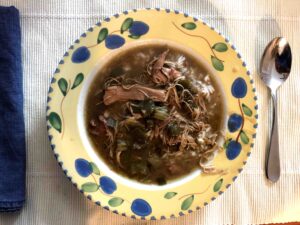In the context of his Pause Midi presentation on Louisiana French, Trenton Holliday has provided his version of this classic Louisiana dish. As a ninth-generation Louisianan, he provides a truly authentic version, although as he notes, every version is personal.
Yield: Serves 8 or more
Ingredients:
1 cup flour
1 cup vegetable oil
1 whole chicken
1 pound andouille sausage
1 big yellow onion, chopped
1 big bell pepper, chopped
¾ bunch of celery, chopped
Minced clove of garlic (or garlic powder to taste)
Salt, black pepper, cayenne pepper, paprika, ground cloves, hot sauce (to taste)
2 cups rice
Preparation
First, boil the chicken in salt water. Try not to make the broth too salty, because you’ll want to be able to salt the gumbo later to taste.
While the chicken is in the pot heating up, make the roux. I mix together the cup of flour (or slightly more than a cup) with the cup of oil in a cold cast iron skillet. Once it is thoroughly mixed, I turn on the heat. I start with the heat pretty high, but adjust it up and down throughout the process. You must stir your roux constantly, or it will burn. What you are hoping to achieve is a dark brown color, which will give the gumbo a smoky flavor. This will likely take about half an hour.
Note: My family always used oil for roux, but some friends of mine use butter. Butter roux is absolutely delicious, but easier to burn. Just substitute two sticks of butter for the cup of oil.
The chicken should be boiled just long enough that you think it might be safe to eat as is, but you probably wouldn’t want to—so it’s just undercooked. If you overboil it, it will come apart in the gumbo. Remove the chicken from the broth and pull the meat from the carcass. I try to keep the pieces of meat as big as possible—they’ll come apart more in the gumbo.
Next, sauté the vegetables in the same skillet you made the roux in. Some people do this in the roux itself; I prefer to pour most of the roux into the pot into which I am going to make the gumbo, and use the leftover roux stuck to the sides of the skillet and added butter to sauté the vegetables. Sauté them until the onions are clear, then add them to the roux.
Add the chicken pieces to the roux as well, stirring the vegetables and chicken until they are coated with roux. Next stir about half of the chicken broth you made into the roux, chicken, and vegetables. (Leave room in the pot for the sausages that you’ll add later.) Add your salt and spices, too, but with a gentle hand—you can always add more later, but you can’t remove any!
Stir and then cook over low heat, stirring occasionally. I tend to do this in a crockpot for about 8 hours – a gumbo really needs time to mellow. After a couple of hours, taste the gumbo, and if it needs more salt or pepper (and I love cloves in my gumbo, but they are not for everyone), add what you think it needs, but be careful not to oversalt it.
About 2-3 hours before you intend to serve the gumbo, add the sausages, which you have cut into little circular segments about ¼ inch thick. After the sausages have cooked for an hour or so, taste the gumbo one last time before serving. Make any final adjustments in terms of salinity or spice. (The sausages add salt, so this is another reason not to oversalt it earlier.)
Last, cook the rice in its own pot, and serve the gumbo over rice. (Along Bayou LaFourche, they substitute potato salad or mashed potatoes for the rice, which is an easy substitution.)
You’ll notice this recipe doesn’t include okra (gombo in Louisiana French). I love okra, but I prefer my gumbo without it. I also prefer it without tomatoes, but feel free to add them if you like. A gumbo is truly a idiosyncratic mix—you can make this recipe your own by taking away or adding any number of things.
This recipe makes a pretty thick gumbo, but if you or your guests want to thicken it more, add filé (ground sassafras leaves) to your bowl right before you eat it. This is what makes it a “filé gumbo.”
